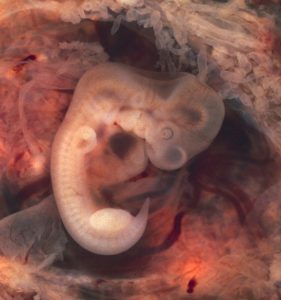Friend, have you ever heard of ectopic pregnancy or tubal pregnancy? Both refer to the same thing, because when an egg is released and fertilized by a sperm, they meet in the fallopian tube and, after fertilization, it travels down to the uterus.
If you have gone through this, you know how challenging it can be to cope with such a loss. That’s why I recommend seeking a psychologist with experience in counseling women trying to conceive. Learn about Famivita’s psychology service and enjoy a free first evaluation session. Click here to learn more!
How an Ectopic Pregnancy Happens
The question of what an ectopic pregnancy is remains a big question mark for parents who receive this diagnosis. In the case of an ectopic pregnancy, the zygote does not descend to the uterus and instead implants right there in the tube. However, the tube is not an elastic organ like the uterus and is not prepared to accommodate a growing fetus1. 
Signs of Ectopic Pregnancy
When a pregnancy occurs in the tube, at first the signs are the same as those of a normal pregnancy, but over time, if proper prenatal care is not given, the mother starts feeling severe (increasingly intense over time) pain on only one side of the abdomen2, and may even have her period, since the fetus is not in the uterus but in the tube. Another symptom of ectopic pregnancy is the appearance of very intense and rapid swelling in one side of the abdomen, but this does not mean that if you develop a little bump early on in a normal pregnancy, your pregnancy is ectopic, since tubal pregnancy occurs in about 1.5% of pregnancies—a very small number, so don’t worry. Talk to your doctor and get an ultrasound if you have any doubts to put your mind at ease.
How to Diagnose Ectopic Pregnancy
Diagnosis of ectopic pregnancy can be carried out through blood tests, pelvic exams, and ultrasound scans. These exams will be requested after observation of several symptoms pointing to an ectopic pregnancy, such as severe abdominal pain, bleeding, and quick increase and swelling of the abdomen. In some cases, laparoscopy may be indicated to find the ectopic pregnancy, however, this surgical procedure is very rarely needed for this purpose, since blood tests and ultrasound scans can achieve quite precise diagnoses.
Who’s at Risk for an Ectopic Pregnancy?
In reality, an ectopic pregnancy can happen to any woman and at any age, but some factors3 can increase the risk, such as:
- Women with tubal endometriosis;
- After any kind of abdominal surgery, such as: cesarean, appendix removal, or even tubal ligation reversal;
- Pregnancy resulting from IVF;
- Women who have had chlamydia or gonorrhea;
- Becoming pregnant with an IUD in place.
Treatment of Ectopic Pregnancy
Unfortunately, tubal pregnancy is not a viable pregnancy, because the tube would not withstand the entire pregnancy, and, as mentioned, it is not prepared to grow and stretch like the uterus. To treat ectopic pregnancy, surgery is required to remove the tube and the gestational sac (salpingectomy), or just the gestational sac (salpingostomy). The tube must be removed to prevent rupture or internal hemorrhage. Folks, this is a topic that can scare many women, as it is very serious. But know that, if identified early, it is possible to preserve the fallopian tube without any risk. I hope I helped! See you next time. Photo: Ed Uthman











